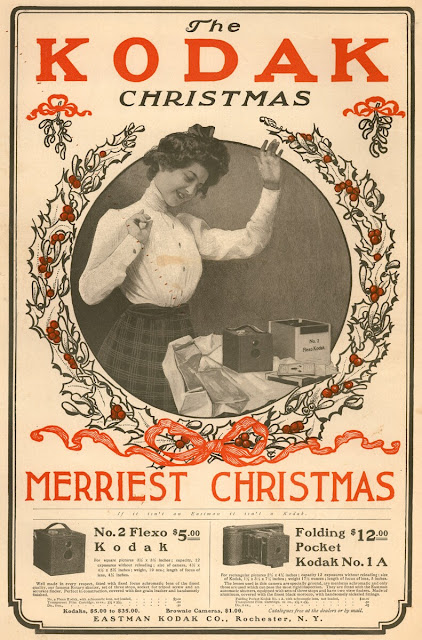A holiday short story wrapped in an old photograph.
The fragrance of fir tree and rosemary swirled through the room as Anja cleared the table, skillfully balancing the tray in one hand while collecting cutlery and plates. The girls had finished their supper early and brought their new dolls to the table.
"Careful, Katharina," she admonished. "You don't want to soil her frock. Uncle Eduard will be very displeased if you treat his gift so mean."
"Have you given your dolly a name, little Kathi?" asked Eduard. "She must have a name for a proper introduction to your other friends." He gave his guitar a quick strum for emphasis.
"Her name is ... is ..." The child paused. "Lena!"
He bowed his head and shook the small porcelain hand. "How do you do, Miss Lena? So nice to make your acquaintance."
"Oh, Uncle Eddie, please play some dance music for my doll too," cried Isabell. "You and Papa and Uncle Josef know so many good ones." She lifted onto her toes and spun her doll through the air.
"Brother, have you met Lena, my dearest friend?" He plucked out a slow waltz beat. "She is the most beautiful dancer at the New Year's ball. And Felix, you will be most charmed by her artful footwork."
Josef took up his horn and began a slow four note arpeggio. Felix raised his bow and the violin slid in with the soft counter melody. Isabell's eyes widened. "Yes, yes, the Blue Danube. My favorite!"
The sound of horn, violin and guitar now filled the house with a different perfume, thought Anja. As she bent over the table, Marie gave her a kiss. "That was a wonderful dinner, Anja. So delicious. Don't you think so, mother?"
The old woman cupped her ear and nodded. "Ja, sehr sehr gut. Ein vorzügliches Abendessen." Her eyelids slowly closed as she rocked to the music.
"Thank you, Mother Sophie." she smiled. "I was so lucky to get the best cuts at Schroeder's. Though I'm sure it was still not as tender as those in Dresden"
"Nonsense," said Marie. "It is the cook who makes the meal. Josef is so lucky to have such a talented wife. I'm afraid my Felix must suffer through too many of my poor suppers. Sometime you must show me how you did that sauce." She stroked the little girl's hair. "What do you say Frieda? Shall we learn to make Zwiebelkuchen for Papa and Isabell?"
Anja finished with the remaining dishes and brought out the platter of special Christmas cakes and chocolate treats. The girls squealed in delight and abandoned all thoughts of dancing dolls. The musicians now segued into Oh, Tannenbaum. The horn and violin alternated the high and low phrases and Eduard sang in falsetto making the children laugh.
As they paused to take refreshment, Josef set his horn down and reached behind the tree. He turned toward Anja and placed a parcel wrapped in brown paper before her. "This is for you, my sweet. Father Christmas has left you a gift because you have been so good and kind this year."
She gave him a playful frown and began to untie the string. "What have you done, Josef? You know we must not spend more money right now." She removed the paper and held up a cardboard box. This time the frown was more serious.
"Open it," he said, giving the box a nudge. She unfolded the lid and pulled out a smaller box covered in black leatherette.
"What is it, Mama?" said Kathi.
"It's a camera!" she gasped. "Oh, thank you, Josef. It is just like the one in Herr Schneider's shop window. I saw him put up the display last week, and he showed me how it works."
Josef smiled. "Yes, I know. He has always spoken highly of your photography skills when you worked for him in his studio. His son plays viola alongside Eduard in the orchestra. He thought this new camera would be perfect for a lady to take on a holiday. I thought so too." Her face changed to a mixture of joy and puzzlement. "Yesterday after the concert, Mr. Muller announced that the orchestra will go on tour this spring to finish the season. We perform in Boston and Philadelphia too."
"But Josef, what did you mean by holiday? Kathi and I can not travel with you and the orchestra on the train."
"No, not on the train. But on a ship you can. Tell her, Felix"
"My cousin Otto leads a small salon orchestra on the SS Kronprinz Wilhelm. He needs substitute musicians in May for the the return voyage to Bremen." Felix selected another chocolate. "I wrote to him about my wife's very musical brothers, and he agreed to engage Josef and Eduard to play in his band."
"Would you like that?" asked Josef. "You and Kathi may travel for a discounted ticket. And with the extra money I make on this tour, I thought we could take a summer holiday back to Germany. A real adventure." He picked up his horn again and blew a loud fanfare. "I knew you wanted to send some photographs to your father in Berlin. But now we can take Katharina in person to visit him. And with the camera, you can take photographs of all the wonderful things we see on the trip to save for the family here. What do you think?"
She laughed and stepped back with the camera. "Yes, I would like that very much," she said. Twisting the box, she squinted into the viewfinder. "But I do not need to travel across the ocean to see wonderful things." She clicked the shutter.
My holiday contribution to Sepia Saturday
Click the link to find more enthusiasts of vintage photographs.









































